The Golden Gate Bridge consists of multiple sections. The suspension bridge is the longest section (1.2 miles, 6,450 ft, 1966 m).
Anatomy of a Suspension Bridge
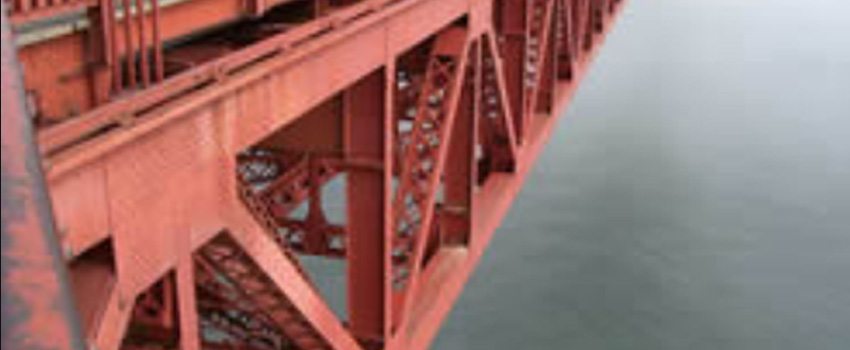 l. Deck Trusses
l. Deck Trusses
Look at the trusses that extend along the length of the Bridge. The weight of the roadway and sidewalk structure, and of the cars, pedestrians, and bicyclists, is supported by the deck trusses. The diagonal struts outline the basic structural unit of a truss, the triangle, which is inherently strong and stiff. However, the deck trusses are not strong enough to span all the way across the Golden Gate. They are held up every 50 feet (15 meters) by vertical steel suspender ropes.
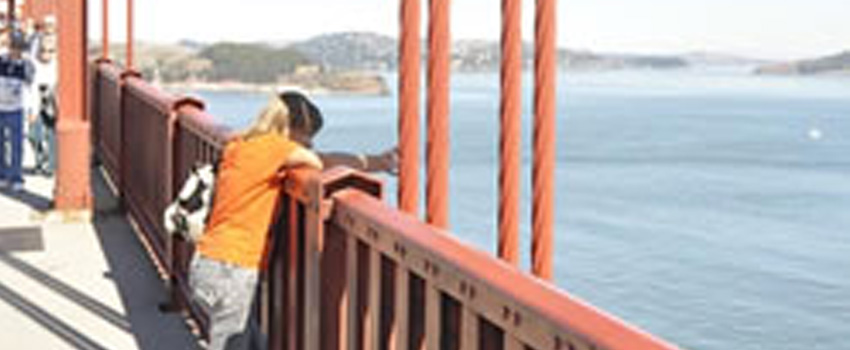 2. Suspender Ropes
2. Suspender Ropes
See the 500 vertical lines (steel suspender ropes) across the Bridge? They are the next step in the “load path”, which is the term that describes how the weight of the Bridge, including the weight of traffic, is transferred ultimately to the ground. The deck trusses hand off their load to the ropes, which pull that weight up to the curving main cables. The weight of the deck is suspended from the main cables by these suspender ropes, hence their name.
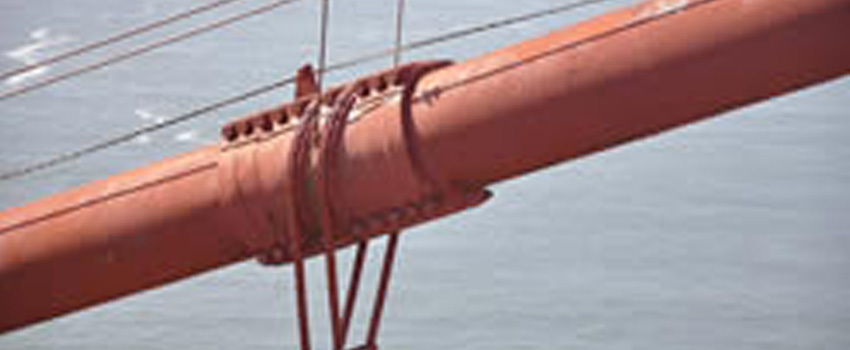 3. Main Cables
3. Main Cables
When you look at the tops of the two towers of the Bridge, you see where the two cables are supported. All the weight of the roadway and sidewalk deck structure, the traffic, the steel suspender ropes, and the self-weight of the curving main cables, is placed on the tops of the two towers by the cables.
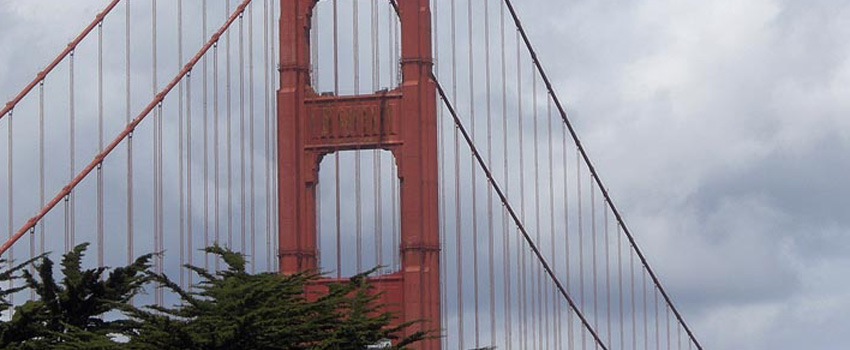 4. Towers
4. Towers
What holds up the two main cables? When you wear a backpack, the straps pull the weight up to your shoulders, and then that load must travel a path down your body all the way through your legs to the ground. The poles that hold up a tent, or a tightrope walker at the circus, or a clothesline, must also carry the weight to the ground. In the Bridge, the towers carry all the gravity loads of the entire suspension structure, from one end to the other, down to the ground.
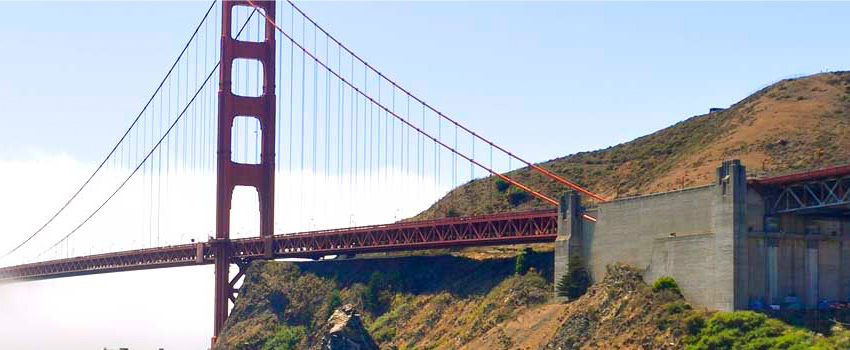 5. Foundations
5. Foundations
The foundations are the final step in the load path. The forces carried down through the steel towers are resisted by the strength of the concrete foundations, which extend into bedrock. The pulling or tension forces in the cables are resisted by the massive concrete anchorages at both ends of the Bridge, and those anchorages are also embedded in bedrock. The loads of the Bridge flow through the foundations and reach the earth, completing the load path.
Explore this Topic Further
Types of Bridges and Their Performance
Bridges: An Integrated Teaching Guide from The Works (grades 4-8)
This guide provides an inquiry-based instructional unit designed to teach students about types of bridges and principles involved in their construction. The activities include suggested readings, materials lists, instructions, and handouts. The lessons incorporate principles of science, history, mathematics, engineering and English/language arts for students in grades 4-8.
The Golden Gate Bridge: From U.S. History to Physics from The Wright Center for Science Education (grades 3-9)
Developed by two high school teachers, this set of activities guides students through science and history of the Golden Gate Bridge. It includes student work sheets and teacher answer sheets. A few of the web links are out of date (55 pages)
List of Longest Suspension Bridges from Wikipedia (all ages)
As of September 2014, the Golden Gate Bridge is the 12th longest suspension bridge in this world. This Wikipedia page provides a list of more than 100 of the longest suspension bridges in the world.
Build a Bridge from NOVA (grades 3-12)
This online challenge asks the user to decide which type of bridge is best for each of four different sites. Three spans are over water, one over land. Each has a different length to be crossed. The challenge walks the user through the characteristics of and construction constraints for each bridge type.
Modeling Truss Structures from pbslearningmedia.org (grades K-2)
David Macaulay describes the forces at work in a cantilever bridge and explains how the bridge's design uses some of these forces to create a very strong and stable span. This resource is useful for introducing components of Engineering Design (ETS) from the Next Generation Science Standards (NGSS) to grades K-2 students. (1 minute video)
Train Truss Animation from pbslearningmedia.org (grades 3-12)
Using colors, the animation shows the members of a truss-stiffened bridge experiencing tension or compression when a train passes over. (40 second video)
Hands-on Bridge Construction and Analysis
Popsicle Bridge from tryengineering.org (grades 3-12)
The lesson focuses on how bridges are engineered to withstand weight, while being durable, and in some cases aesthetically pleasing. In this challenge, teams design and build their own bridge out of popsicle sticks and glue. The lesson plan includes background information, procedure, student worksheets, and links to various standards.
Designing File Folder Bridges by Stephen Ressler (grades 9-12, college)
This online book is a companion to the West Point Bridge Designer software with the purpose of providing students with an opportunity to learn how engineers use math, science, and technology to design real structures. The book includes five major learning activities associated with designing and testing a trust bridge as well as many of the mathematical and scientific concepts that engineers use to analyze and design real structures.
West Point Bridge Designer Contest and Software from Engineering Encounters (grades 6-12, college)
This educational software, developed by two West Point professors, runs on PC or Mac platforms and allows students to simulate the performance of a truss bridge when a truck drives over it. The software can be use by itself or to support entries in to the annual Engineering Encounters Bridge Design Contest. The goal of the contest is to provide middle school and high school students with a realistic, engaging introduction to engineering.
Bridge Load Path
The Golden Gate Bridge – (grades 9-12, College)
This chapter by Thalia Anagnos found in the textbook Statics by Sheri Sheppard and Benson Tongue (Wiley, 2007) traces the loads through the elements of the Golden Gate Bridge. Several hands-on activities for exploring the loads on other bridge types are included at the end of the chapter.